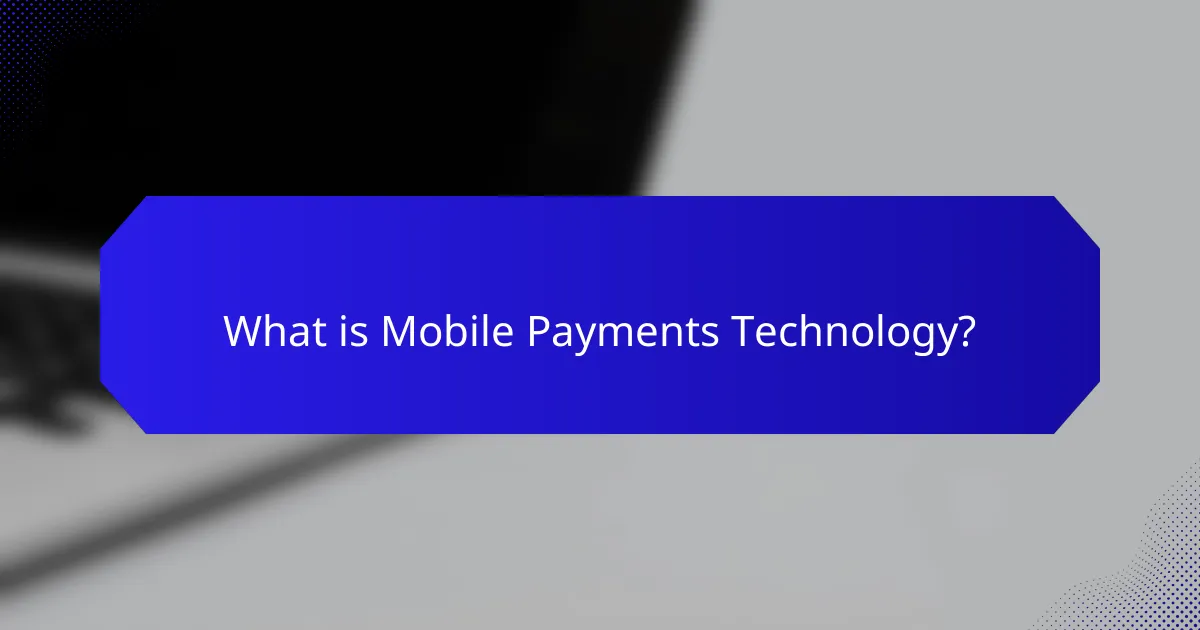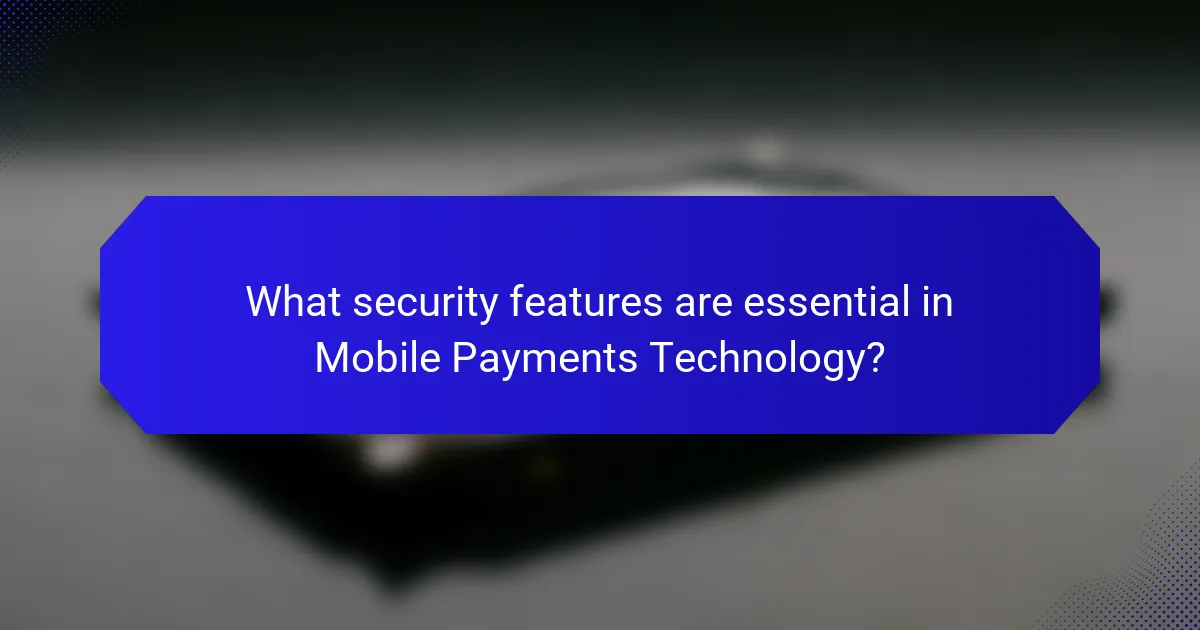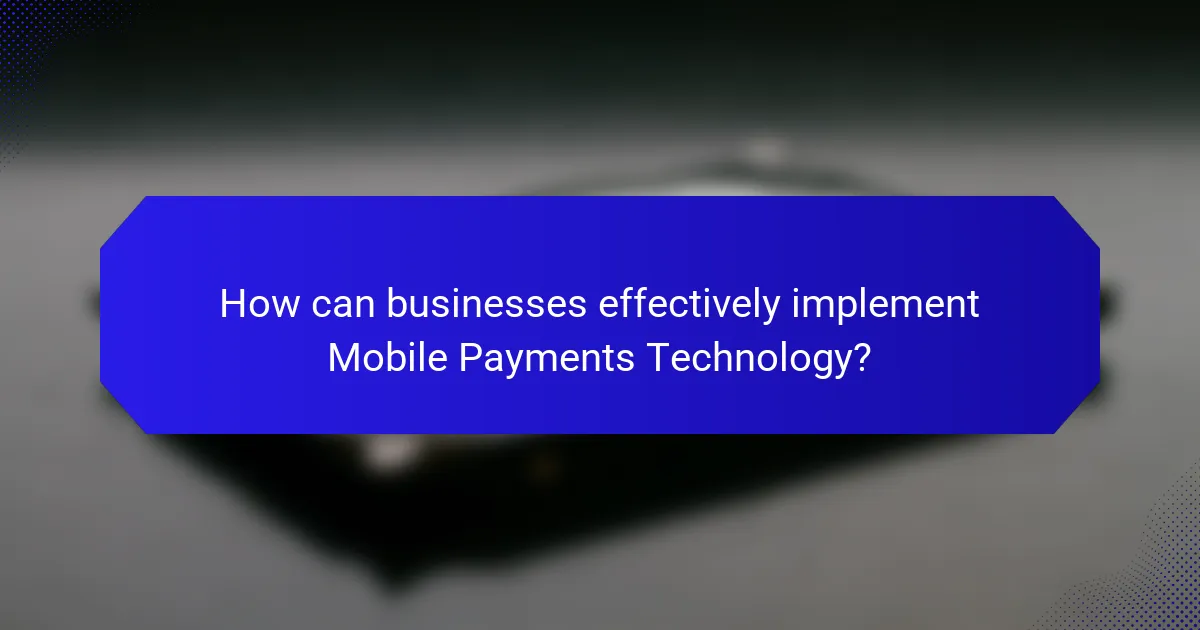Mobile payments technology enables financial transactions through mobile devices using applications or digital wallets, employing methods such as Near Field Communication (NFC) and QR codes. This article examines the significant growth of the mobile payment market, projected to reach $4.5 trillion by 2023, highlighting the convenience and security features associated with these transactions. Key security elements include encryption, tokenization, biometric authentication, and fraud detection systems, all designed to safeguard sensitive information. The article also outlines best practices for businesses to implement mobile payment solutions effectively, emphasizing the importance of secure payment gateways, user experience optimization, and ongoing security updates to protect customer data.

What is Mobile Payments Technology?
Mobile payments technology refers to the use of mobile devices to conduct financial transactions. This technology enables users to make payments through applications or digital wallets. Mobile payments can be processed using Near Field Communication (NFC), QR codes, or online payment platforms. According to a report by Statista, the global mobile payment market is expected to reach $4.5 trillion by 2023. This growth indicates a significant shift towards digital transactions. Mobile payments enhance convenience by allowing users to pay anytime and anywhere. Additionally, they often incorporate security features like encryption and biometric authentication. These features help protect sensitive information during transactions.
How does Mobile Payments Technology enhance cost efficiency?
Mobile payments technology enhances cost efficiency by reducing transaction costs and streamlining payment processes. It eliminates the need for physical cash handling, which can incur labor and security expenses. Additionally, mobile payments facilitate quicker transactions, leading to shorter wait times and increased customer turnover. Research indicates that businesses can save up to 2-3% on transaction fees compared to traditional credit card processing. Mobile payments also reduce the need for infrastructure investments, as they leverage existing mobile networks. This technology allows for better inventory management through real-time data access, further optimizing operational costs.
What are the key features of Mobile Payments Technology that contribute to cost savings?
Mobile Payments Technology offers several key features that contribute to cost savings. First, it reduces transaction fees compared to traditional payment methods. Mobile payments often have lower processing costs, benefiting both consumers and businesses. Second, the technology streamlines payment processes, minimizing the time spent on transactions. Faster transactions lead to increased efficiency and reduced labor costs. Third, mobile payments enhance inventory management through real-time data tracking. This capability reduces overstock and stockouts, saving costs associated with excess inventory. Fourth, mobile payments can lower fraud-related expenses, as they often include advanced security features like tokenization and encryption. These features protect sensitive information and reduce the risk of chargebacks. Lastly, mobile payments improve customer retention through convenience, leading to repeat business and increased revenue. According to a report by McKinsey & Company, businesses adopting mobile payment solutions can save up to 30% in transaction-related costs.
How do transaction speeds impact overall cost efficiency?
Transaction speeds directly affect overall cost efficiency by influencing operational costs and customer satisfaction. Faster transactions reduce waiting times, leading to increased throughput in retail settings. This higher volume of transactions can lower the cost per transaction. Additionally, quicker processing minimizes the risk of cart abandonment, enhancing sales revenue. Research indicates that a one-second delay can lead to a 7% reduction in conversions for online retailers. Thus, optimizing transaction speeds can significantly enhance profitability and operational efficiency.
What role does user experience play in Mobile Payments Technology?
User experience is crucial in mobile payments technology as it directly influences user adoption and satisfaction. A seamless and intuitive interface encourages users to engage with mobile payment systems. According to a study by PWC, 73% of consumers cite ease of use as a key factor in their choice of mobile payment methods. Additionally, positive user experiences lead to increased transaction frequency. Research indicates that 60% of users abandon mobile payment apps due to poor usability. Therefore, enhancing user experience is essential for driving growth in mobile payment adoption.
How can a seamless user experience reduce operational costs?
A seamless user experience can reduce operational costs by minimizing user errors and support requests. When users navigate a system easily, they require less assistance. This decreases the workload on customer service teams. For example, a study by Forrester Research found that improving user experience can lead to a 50% reduction in support calls. Additionally, streamlined processes can enhance transaction speed, reducing time spent on each interaction. Faster transactions lead to increased customer satisfaction and retention. Higher retention rates lower the costs associated with acquiring new customers. Overall, a seamless user experience directly contributes to lower operational expenses through efficiency and reduced support needs.
What are common user pain points in Mobile Payments Technology?
Common user pain points in mobile payments technology include security concerns, transaction failures, and usability issues. Users often worry about the safety of their personal and financial information. According to a survey by Statista, 30% of respondents cited security as a primary concern in mobile payments. Transaction failures can lead to frustration and distrust in the technology. Many users experience difficulties navigating apps, leading to a poor user experience. Additionally, compatibility issues with different devices can hinder seamless transactions. These pain points highlight the need for improved security measures and user-friendly interfaces in mobile payment systems.

What security features are essential in Mobile Payments Technology?
Essential security features in mobile payments technology include encryption, tokenization, biometric authentication, and fraud detection systems. Encryption protects data during transmission, ensuring that sensitive information remains secure. Tokenization replaces sensitive data with unique identifiers, reducing the risk of data breaches. Biometric authentication, such as fingerprint or [censured] recognition, adds an additional layer of security by verifying the user’s identity. Fraud detection systems analyze transaction patterns to identify and prevent fraudulent activities in real-time. These features collectively enhance the security of mobile payments and protect user information from unauthorized access.
How do encryption and tokenization protect user data?
Encryption and tokenization protect user data by transforming sensitive information into secure formats. Encryption uses algorithms to convert data into unreadable code, making it accessible only to authorized users with the decryption key. Tokenization replaces sensitive data with unique identifiers or tokens that have no exploitable value. This means that even if data is intercepted, it cannot be used without the corresponding tokenization system.
According to the 2021 Verizon Data Breach Investigations Report, 61% of data breaches involved credential theft, highlighting the importance of protecting sensitive information. By employing encryption and tokenization, organizations can significantly reduce the risk of unauthorized access and data breaches. These methods ensure that user data remains confidential and secure in mobile payment transactions.
What are the differences between encryption and tokenization?
Encryption converts data into a secure format that can only be read with a decryption key. Tokenization replaces sensitive data with unique identifiers called tokens. Encryption protects data confidentiality by making it unreadable without a key. Tokenization reduces risk by substituting sensitive information, thus minimizing exposure. In encryption, the original data can be restored using the key. In tokenization, the original data is not stored with the tokens, making it less vulnerable. Encryption is often used for data in transit and at rest. Tokenization is commonly used for payment processing to protect cardholder information.
How effective are these security measures in preventing fraud?
These security measures are highly effective in preventing fraud. They employ advanced encryption, multi-factor authentication, and real-time transaction monitoring. Encryption protects sensitive data during transmission. Multi-factor authentication adds an extra layer of security by requiring additional verification. Real-time monitoring detects suspicious activities instantly. According to a study by Javelin Strategy & Research, mobile payment fraud rates decreased by 30% due to these measures. This demonstrates that implementing robust security features significantly enhances fraud prevention in mobile payments.
What compliance standards must Mobile Payments Technology adhere to?
Mobile Payments Technology must adhere to several compliance standards. Key standards include PCI DSS, which ensures secure handling of cardholder data. Another important standard is GDPR, which governs data protection and privacy in the European Union. Additionally, AML regulations focus on preventing money laundering and terrorist financing. The Electronic Fund Transfer Act (EFTA) regulates electronic payments in the United States. Compliance with these standards is crucial for maintaining security and trust in mobile payment systems.
How does PCI DSS compliance enhance security for users?
PCI DSS compliance enhances security for users by establishing a set of security standards for payment card transactions. These standards protect cardholder data from theft and fraud. Compliance requires encryption of sensitive data during transmission. It also mandates regular security testing and vulnerability assessments. Organizations must implement strong access control measures. This limits access to sensitive information to authorized personnel only. Additionally, compliance involves maintaining a secure network infrastructure. This reduces the risk of data breaches. According to the PCI Security Standards Council, adherence to these standards significantly lowers the likelihood of data compromise.
What are the implications of non-compliance for businesses?
Non-compliance can lead to significant financial penalties for businesses. Regulatory bodies impose fines that can reach millions of dollars. Businesses may also face legal action from consumers or other entities. This can result in costly litigation expenses. Additionally, non-compliance can damage a company’s reputation. Loss of customer trust often leads to decreased sales. Furthermore, businesses may experience operational disruptions due to compliance audits. This can divert resources away from core activities. In 2022, the average fine for non-compliance in the financial sector was reported at $1.5 million.

How can businesses effectively implement Mobile Payments Technology?
Businesses can effectively implement mobile payments technology by integrating secure payment gateways. This ensures that transactions are processed safely and efficiently. They should choose a mobile payment platform that supports various payment methods. This increases customer convenience and satisfaction. Training staff on using mobile payment systems is essential. Well-trained employees can assist customers and resolve issues quickly.
Additionally, businesses must ensure their website or app is optimized for mobile payments. A seamless user experience encourages repeat transactions. Regularly updating security measures is crucial. This protects sensitive customer data from breaches. According to a report by Statista, mobile payment transactions are expected to reach $12 trillion globally by 2025. This highlights the importance of adopting mobile payment technology for future growth.
What best practices should businesses follow for successful implementation?
Businesses should follow a structured approach for successful implementation of mobile payment technology. First, they must conduct a thorough needs assessment. This assessment identifies specific requirements and goals related to cost efficiency and user experience. Next, businesses should choose a reliable technology partner. A partner with proven expertise enhances security and functionality.
Training staff is also crucial for effective implementation. Well-trained employees can assist customers and mitigate security risks. Additionally, businesses should prioritize user experience. A seamless interface encourages customer adoption and satisfaction. Regularly updating the technology is essential to address security vulnerabilities.
Monitoring performance metrics helps businesses evaluate the effectiveness of the implementation. According to a study by the Federal Reserve, 75% of businesses that utilized mobile payments saw improved transaction speed and customer satisfaction. Following these best practices can lead to successful integration of mobile payment technology.
How can businesses train employees to use Mobile Payments Technology effectively?
Businesses can train employees to use Mobile Payments Technology effectively by implementing structured training programs. These programs should include hands-on workshops that allow employees to practice using the technology. Providing clear, easy-to-understand manuals or guides enhances learning retention. Regular refresher courses keep employees updated on new features and security protocols.
Incorporating real-life scenarios during training helps employees understand practical applications. Utilizing feedback mechanisms allows employees to voice challenges and improve training methods. Statistics show that businesses with comprehensive training programs see a 30% increase in employee competency with new technologies.
By fostering a supportive learning environment, businesses can ensure employees feel confident using mobile payment systems.
What strategies can businesses employ to encourage user adoption?
Businesses can employ several strategies to encourage user adoption of mobile payment technology. First, they should provide user-friendly interfaces that simplify the payment process. Research shows that 70% of users abandon apps due to poor usability. Offering incentives, such as discounts or cashback, can also motivate users to adopt the technology. A study found that 60% of users are more likely to try a new payment method when financial incentives are offered. Educating users about security features builds trust and reduces hesitation. According to surveys, 80% of consumers express concerns about security in mobile payments. Regular updates and improvements based on user feedback enhance user satisfaction and retention. Data indicates that businesses that actively engage with user feedback see a 50% increase in retention rates. Lastly, ensuring compatibility with various devices and platforms broadens accessibility and encourages adoption.
What are the common challenges faced during implementation?
Common challenges faced during implementation include integration issues, user adoption resistance, and security concerns. Integration issues arise when mobile payment systems do not seamlessly connect with existing infrastructure. This can lead to operational disruptions and increased costs. User adoption resistance occurs when consumers or businesses are hesitant to change their payment methods. This reluctance can slow down the transition to mobile payments. Security concerns are paramount, as users worry about data breaches and fraud. According to a 2021 survey by McKinsey, 32% of consumers cited security as a primary barrier to mobile payment adoption. Addressing these challenges is crucial for successful implementation.
How can businesses address security concerns from users?
Businesses can address security concerns from users by implementing robust security measures. These measures include end-to-end encryption to protect sensitive data during transactions. Regular security audits help identify vulnerabilities in systems. Additionally, businesses should educate users about safe practices, such as recognizing phishing attempts. Multi-factor authentication adds an extra layer of protection for user accounts. Compliance with industry standards, such as PCI DSS, ensures adherence to security protocols. Providing clear privacy policies builds user trust. Finally, offering responsive customer support can address security-related inquiries promptly.
What solutions exist for technical issues during implementation?
Solutions for technical issues during implementation include thorough testing, user training, and robust support systems. Thorough testing identifies bugs before deployment. User training ensures that all stakeholders understand the system. Robust support systems provide immediate assistance during technical failures. Regular updates and maintenance can prevent future issues. Engaging with experienced technical teams can also streamline the implementation process. These strategies have been shown to enhance user experience and reduce downtime in mobile payment systems.
What are practical tips for optimizing user experience in Mobile Payments Technology?
To optimize user experience in mobile payments technology, ensure a seamless and intuitive interface. Simplify navigation to reduce user effort during transactions. Implement biometric authentication for enhanced security and convenience. Provide clear feedback during payment processing to keep users informed. Offer multiple payment options to cater to diverse user preferences. Optimize load times to prevent frustration and abandonment. Regularly update the app to fix bugs and improve performance. Use data analytics to understand user behavior and tailor experiences accordingly.
Mobile payments technology is the primary focus of this article, which explores its role in enhancing cost efficiency through various features and security measures. The article highlights how mobile payments streamline transactions, reduce costs, and improve user experience while addressing common pain points such as security concerns and usability issues. Key security features like encryption and tokenization are discussed in relation to their effectiveness in preventing fraud and ensuring compliance with industry standards. Additionally, the article provides practical strategies for businesses to implement mobile payment solutions effectively, optimizing user adoption and experience.
